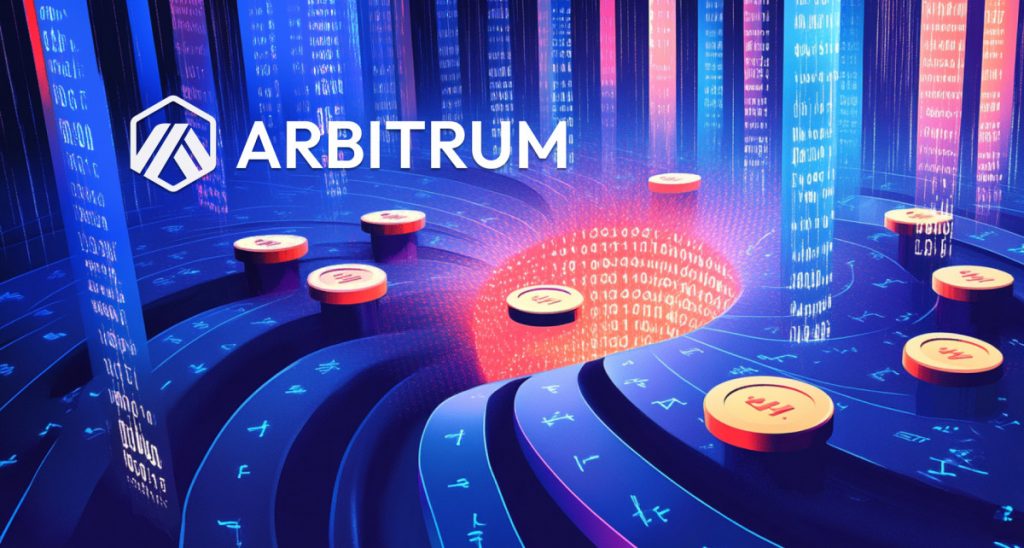Alisa Davidson
Revealed: April 17, 2025 at 3:00 pm Up to date: April 17, 2025 at 9:28 am

Edited and fact-checked:
April 17, 2025 at 3:00 pm
In Transient
Arbitrum launched Timeboost on its Arbitrum One community, a brand new transaction ordering mechanism meant to handle community congestion, transaction spam, and latency-based competitors.

Layer 2 scaling answer Arbitrum launched Timeboost on its Arbitrum One community, describing it as a brand new transaction ordering mechanism meant to handle frequent points equivalent to community congestion, transaction spam, and latency-based competitors.
At the moment, Arbitrum follows a “First-Come, First-Serve” (FCFS) transaction ordering mannequin, which offers a usually optimistic consumer expertise and protects in opposition to sure sorts of dangerous miner extractable worth (MEV). Nevertheless, based on the group, a lot of the MEV exercise on the chain entails searchers investing closely in quicker {hardware} or spamming transactions to achieve a aggressive edge in latency-sensitive eventualities—conduct that contributes to pointless community pressure.
Timeboost is designed instead ordering method that maintains the benefits of FCFS whereas additionally introducing a mechanism for lowering latency-related competitors. It does this by implementing a sealed-bid, second-price public sale system tied to an “categorical lane” inside the Arbitrum sequencer. Transactions submitted via this categorical lane are sequenced directly, whereas others face a small, predefined delay—at present set at 200 milliseconds. Public sale winners acquire unique, short-term entry to the categorical lane, permitting them to keep away from the delay and have their transactions prioritized.
The introduction of Timeboost is anticipated to permit ecosystem members—particularly chain operators and superior customers equivalent to searchers—to interact in MEV seize in a extra structured, much less disruptive means. As a substitute of investing in {hardware} or partaking in spam to compete, members can allocate sources towards bidding for transaction precedence. For chain homeowners, this will additionally introduce a possible income stream derived from the MEV already being generated on their platforms.
Importantly, Timeboost is an non-compulsory function that may be adopted by Arbitrum chains with both centralized or decentralized sequencer fashions. Whereas the total decentralized design remains to be in growth, the present centralized implementation is publicly obtainable and has been proposed to the Arbitrum DAO to permit earlier deployment. The platform emphasizes that even with Timeboost enabled, the general block time on Arbitrum chains will stay quick—persevering with at 250 milliseconds.
Timeboost Defined: Goal And Implementation
Timeboost is described as a transaction ordering mechanism utilized by Arbitrum chains. It establishes the algorithm that sequencers should comply with when organizing user-submitted transactions. Whereas the present system operates underneath a FCFS mannequin, Timeboost introduces modifications meant to protect lots of FCFS’s benefits whereas addressing a few of its operational inefficiencies. Within the close to time period, the system will function via a single sequencer, although help for decentralized sequencers imposing Timeboost guidelines is deliberate.
The sequencer’s core perform on an Arbitrum chain is to obtain legitimate transactions, organize them primarily based on the transaction ordering coverage, after which distribute the finalized order via a reside feed and in compressed type to the chain’s information availability layer. Timeboost builds on this course of by integrating three key parts. First, it introduces an “categorical lane” that permits qualifying transactions to be processed instantly upon arrival. Second, it makes use of an off-chain public sale—carried out by an autonomous system—to find out which participant controls the categorical lane throughout an outlined time interval. Lastly, a wise contract deployed on-chain data the public sale outcomes and manages the distribution of proceeds, appearing because the authoritative supply of fact.
The public sale cycle is structured round a default 60-second spherical. Transactions not submitted via the categorical lane face an intentional delay of 200 milliseconds to their timestamp, which can consequence of their inclusion within the subsequent block. This synthetic delay, mixed with the continued 250-millisecond block time, ensures the system stays responsive whereas enabling extra environment friendly transaction ordering.
One among Timeboost’s objectives is to take care of a user-friendly expertise, which Arbitrum chains are recognized for, whereas resolving limitations of pure FCFS ordering. The system doesn’t grant public sale winners management over transaction visibility or block ordering—public sale winners solely acquire a brief benefit in transaction processing, not privileged perception into the mempool. As a result of the mempool stays personal, the dangers related to front-running and sandwich assaults are nonetheless mitigated.
Timeboost can be framed as a means to enhance community effectivity and introduce a novel worth seize mechanism. As a substitute of counting on {hardware} benefits or spamming to achieve transaction precedence—a conduct that always results in community congestion—members can now bid for time-based benefits. This shift is anticipated to scale back MEV-driven community spam and redirect competitors towards the public sale course of.
For chain operators, Timeboost affords potential financial advantages. Proceeds from the auctions will be collected in native gasoline tokens and redirected to help purposes, reward customers, or fund growth. This introduces a brand new option to align chain exercise with ecosystem development.
Timeboost is completely non-compulsory and will be enabled on the discretion of particular person Arbitrum chains. Chains can proceed working usually with out it, however people who decide in can customise its configuration to swimsuit particular use circumstances.
The impression of Timeboost varies by consumer group. For on a regular basis customers, the modifications are minimal—non-express lane transactions could expertise a slight enhance in processing time, as much as roughly 450 milliseconds, however protections in opposition to malicious MEV behaviors stay intact because of using a non-public mempool. For chain homeowners, the system offers a possible income stream and a brand new mechanism to reinforce token utility. And for stylish on-chain members, equivalent to arbitrageurs and searchers, Timeboost opens the door to various methods—equivalent to shopping for categorical lane entry or monetizing unused slots—that would show cheaper than earlier MEV techniques reliant on infrastructure or pace alone.
Disclaimer
According to the Belief Challenge tips, please be aware that the data supplied on this web page isn’t meant to be and shouldn’t be interpreted as authorized, tax, funding, monetary, or another type of recommendation. It is very important solely make investments what you’ll be able to afford to lose and to hunt unbiased monetary recommendation if in case you have any doubts. For additional data, we propose referring to the phrases and situations in addition to the assistance and help pages supplied by the issuer or advertiser. MetaversePost is dedicated to correct, unbiased reporting, however market situations are topic to alter with out discover.
About The Writer
Alisa, a devoted journalist on the MPost, focuses on cryptocurrency, zero-knowledge proofs, investments, and the expansive realm of Web3. With a eager eye for rising tendencies and applied sciences, she delivers complete protection to tell and have interaction readers within the ever-evolving panorama of digital finance.
Extra articles

Alisa Davidson

Alisa, a devoted journalist on the MPost, focuses on cryptocurrency, zero-knowledge proofs, investments, and the expansive realm of Web3. With a eager eye for rising tendencies and applied sciences, she delivers complete protection to tell and have interaction readers within the ever-evolving panorama of digital finance.











